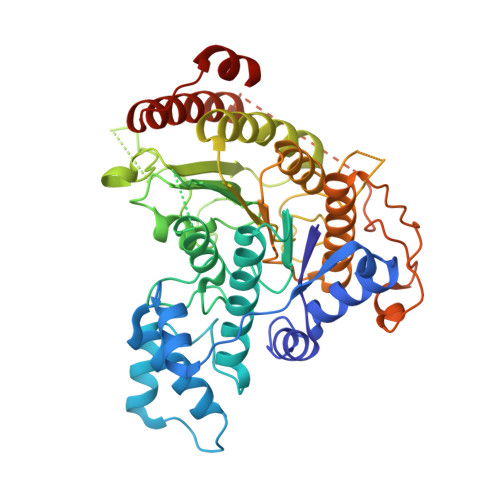Structure-Based Design, Synthesis, and Biological Evaluation of Triazole-Based smHDAC8 Inhibitors.
Kalinin, D.V., Jana, S.K., Pfafenrot, M., Chakrabarti, A., Melesina, J., Shaik, T.B., Lancelot, J., Pierce, R.J., Sippl, W., Romier, C., Jung, M., Holl, R.(2020) ChemMedChem 15: 571-584
- PubMed: 31816172
- DOI: https://doi.org/10.1002/cmdc.201900583
- Primary Citation of Related Structures:
6TLD - PubMed Abstract:
Schistosomiasis is a neglected tropical disease caused by parasitic flatworms of the genus Schistosoma, which affects over 200 million people worldwide and leads to at least 300,000 deaths every year. In this study, initial screening revealed the triazole-based hydroxamate 2 b (N-hydroxy-1-phenyl-1H-1,2,3-triazole-4-carboxamide) exhibiting potent inhibitory activity toward the novel antiparasitic target Schistosoma mansoni histone deacetylase 8 (smHDAC8) and promising selectivity over the major human HDACs. Subsequent crystallographic studies of the 2 b/smHDAC8 complex revealed key interactions between the inhibitor and the enzyme's active site, thus explaining the unique selectivity profile of the inhibitor. Further chemical modifications of 2 b led to the discovery of 4-fluorophenoxy derivative 21 (1-[5-chloro-2-(4-fluorophenoxy)phenyl]-N-hydroxy-1H-1,2,3-triazole-4-carboxamide), a nanomolar smHDAC8 inhibitor (IC 50 =0.5 μM), exceeding the smHDAC8 inhibitory activity of 2 b and SAHA (vorinostat), while exhibiting an improved selectivity profile over the investigated human HDACs. Collectively, this study reveals specific interactions between smHDAC8 and the synthesized triazole-based inhibitors and demonstrates that these small molecules represent promising lead structures, which could be further developed in the search for novel drugs for the treatment of schistosomiasis.
Organizational Affiliation:
Department of Chemistry Institute of Organic Chemistry, University of Hamburg, Martin-Luther-King-Platz 6, 20146, Hamburg, Germany.



















